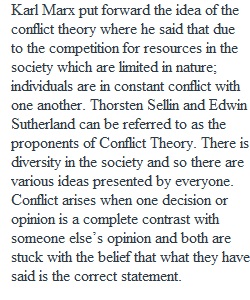


Q A. Discuss the emergence of the conflict view (who were its primary founders and is their sound empirical support for Conflict Criminology today)?
Q B. What does Akers mean when he distinguishes between theoretical competition and theoretical integration?C. Is the criminological discourse multidisciplinary or interdisciplinary? Using the research and the evolution of criminological thought, make your case as to whether criminology is moving toward theoretical integration or theoretical competition? Examples warranted.D. The debate between Gottfredson/Hirschi and Sampson/Laub could be construed as the Hatfield and McCoy dispute of criminology. This debate offers the proverbial cat and dogfight over the causes of crime. What do Gottfredson and Hirschi say is the cause of crime? What do Sampson and Laub say is the cause of crime? E. Which one of these two perspectives (Gottfredson and Hirschi or Sampson and Laub) enjoys more empirical support? Describe why and how you come to this conclusion.
View Related Questions